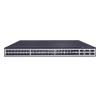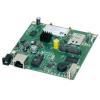-
Kč

Huawei CloudEngine 6881-48S6CQ to zarządzalny switch wyposażony w 48 slotów SFP+ (10 Gb/s) i 6 slotów QSFP28 (100 Gb/s). Urządzenie udostępnia liczne funkcje zarządzania w warstwach Layer2 i Layer3, obsługuje zaawansowaną konfigurację VLAN, w tym QinQ. Doskonale sprawdzi się w transmisji multicast, wspiera IGMP Snooping i routing multicast, w tym PIM-SM i MBGP. Możesz wykorzystać routing IPv4 i IPv6 przy użyciu protokołów RIP, OSPF, IS-IS i BGP.
Za transmisję odpowiada wydajny, czterordzeniowy procesor o taktowaniu 1,4 GHz i 4 GB pamięci RAM. Oferowany produkt wspiera technologie iStack i M-LAG służące do wirtualizacji. Łączna przepustowość wynosi 2,16 Tb/s, a prędkość przekazywania pakietów 940 Mp/s.
Najważniejsze cechy:
- 48 slotów SFP+;
- 6 slotów QSFP28 (100 Gb/s);
- zarządzanie Layer2 i Layer3;
- zaawansowane funkcje zarządzania, w tym m. in. RIP, OSPF, IS-IS, BGP;
- wydajny, czterordzeniowy procesor o taktowaniu 1,4 GHz;
- 4 GB pamięci RAM;
- zasilanie AC.
Specyfikacja:
| CE6881-48S6CQ | |
| Wymiary | 442 x 420 x 43,6 mm |
| Waga |
Bez zasilaczy i wentylatorów: 5,7 kg Z zasilaczem i wentylatorami: 7,8 kg |
| Przepustowość | 2,16 Tb/s |
| Prędkość przekazywania pakietów | 940 Mp/s |
| Sloty SFP+ 10 Gb/s | 48 |
| Sloty QSFP29 40/100 Gb/s | 6 |
| Port zarządzania out-of-band | 1x GE |
| Port konsoli | 1x RJ45 |
| Port USB | 1 |
| Częstotliwość procesora | 1,4 GHz |
| Ilość rdzeni procesora | 4 |
| Pamięć RAM | 4 GB |
| Pamięć NOR Flash | 64MB |
| Pamięć NAND Flash | 4 GB |
| Bufor | 42MB |
| Moduł zasilania | 600W AC |
| Napięcie wejściowe |
100 - 240 V AC |
| Maksymalny zakres napięcia | 90 - 290 V AC |
| Maksymalny prąd wejściowy | 8 A |
| Typowy pobór mocy | 240 W |
| Maksymalny pobór mocy | 349 W |
| Częstotliwość AC | 50 / 60 HZ |
| Sposób chłodzenia | Aktywny |
| Ilość wentylatorów | 4 |
| Bieg powietrza | Front-to-back lub back-to-front |
| Maksymalne wydzielanie ciepła | 1191 BTU/h |
| MTBF | 45,90 lat |
| MTT | 1,57 godzin |
| Dostępność | 0.9999960856 |
| Właściwości środowiskowe | |
|---|---|
| Dopuszczalna temperatura pracy | Od 0 do 40 st. C |
| Dopuszczalna temperatura przechowywania | Od -40 do 70 st. C |
| Dopuszczalna wilgotność powietrza | 5%-95% RH |
| Właściwości oprogramowania | |
| Wirtualizacja | iStack M-LAG |
| Wirtualizacja sieciowa | VXLAN BGP-EVPN QinQ access VXLAN |
| Połączenia wewnątrz data center | VXLAN mapping, implementing interconnection between multiple DCI networks at Layer 2 |
| SDN | iMaster NCE-Fabric |
| Konwergencja sieci | PFC and ECN RDMA and RoCE (RoCE v1 and RoCE v2) |
| Programowalność | PFC and ECN RDMA and RoCE (RoCE v1 and RoCE v2) |
| Analiza ruchu | NetStream sFlow |
| VLAN | Adding access, trunk, and hybrid interfaces to VLANs Default VLAN QinQ |
| Adresacja MAC | Dynamic learning and aging of MAC address entries Static, dynamic, and blackhole MAC address entries Packet filtering based on source MAC addresses MAC address limiting based on ports and VLANs |
| Routing IP | IPv4 routing protocols, such as RIP, OSPF, IS-IS, and BGP IPv6 routing protocols, such as RIPng, OSPFv3, IS-ISv6, and BGP4+ IP packet fragmentation and reassembly |
| IPv6 | VXLAN over IPv6 IPv6 VXLAN over IPv4 IPv6 Neighbor Discovery (ND) Path MTU Discovery (PMTU) TCP6, IPv6 ping, IPv6 tracert, IPv6 socket , UDP6, and Raw IP6 |
| Multicasty | Multicast routing protocols such as IGMP, PIM-SM, and MBGP IGMP snooping IGMP proxy Fast leaving of multicast member interfaces Multicast traffic suppression Multicast VLAN |
| Niezawodność | Fine-grained microsegmentation isolation Link Aggregation Control Protocol (LACP) STP, RSTP, VBST, and MSTP BPDU Guard Smart Link and multi-instance Device Link Detection Protocol (DLDP) Hardware-based Bidirectional Forwarding Detection (BFD) VRRP, VRRP load balancing, and BFD for VRRP BFD for BGP/IS-IS/OSPF/Static route BFD for VXLAN |
| QoS | Traffic classification based on Layer 2, Layer 3, Layer 4, and priority information ACL, CAR, re-marking, and scheduling Queue scheduling modes such as PQ,DRR and PQ+DRR Congestion avoidance mechanisms, including WRED and tail drop Traffic shaping |
| O&M | iPCA (Packet Conservation Algorithm for Internet) Network-wide path detection Telemetry ERSPAN+ Statistics on the buffer microburst status VXLAN OAM: VXLAN ping and VXLAN tracert |
| Konfiguracja | Console, Telnet, and SSH terminals Network management protocols, such as SNMPv1/v2/v3 File upload and download through FTP and TFTP BootROM upgrade and remote upgrade Hot patches User operation logs Zero Touch Provisioning (ZTP) |
| Zabezpieczenia | Command line authority control based on user levels, preventing unauthorized usersfrom using commands Defense against DoS address attacks, ARP storms, and ICMP attacks Port isolation, port security, and sticky MAC Binding of the IP address, MAC address, port number, and VLAN ID Authentication methods, including AAA, RADIUS, and HWTACACS Remote Network Monitoring (RMON) |
| Wydajność i skalowalność | |
| Maks. ilość adresów MAC | 256K |
| Maks. ilośc tras IPv4/IPv6 | 256K/80K |
| Rozmiar tablicy ARP | 256K |
| Maks. ilość VRF | 4096 |
| Rozmiar tablicy IPv6 ND | 80K |
| Maks. ilość tras multicast IPv4/IPv6 |
32K/2K |
| Maks. ilość grup VRRP | 1024 |
| Maks. ilość ścieżek ECMP | 128 |
| Maks. ilość ACL | 30K |
| Maks. ilość domen brodcast | 8K |
| Maks. ilość BDIF | 8K |
| Maks. ilość tuneli VTEP | 2K |
| Maks. ilość grup lag | 1024 |
| Maks. ilość połączeń w grupie lag | 128 |
| Maks. ilość instancji MSTP | 64 |
| VBST | 1000 |






 Polski
Polski English
English Italiano
Italiano Español
Español Čeština
Čeština Српски
Српски Deutsch
Deutsch Ελληνικά
Ελληνικά Slovenský
Slovenský









